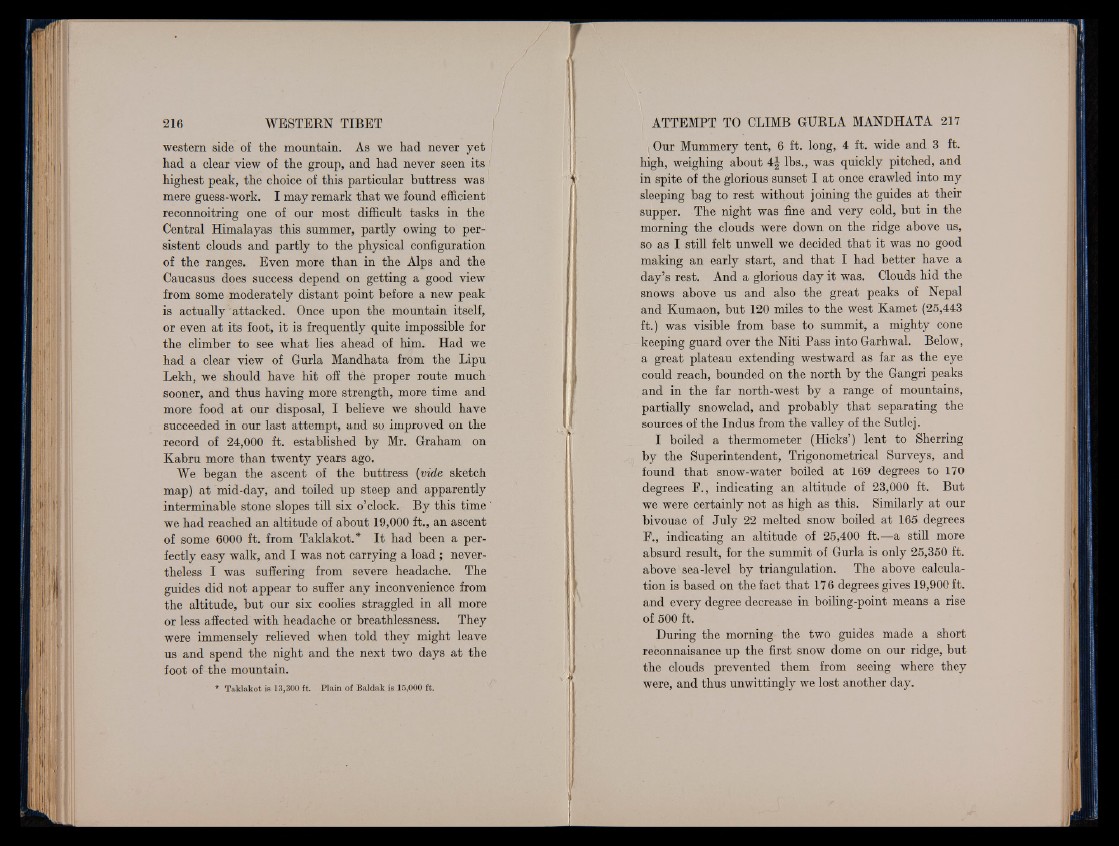
western side of the mountain. As we had never yet
had a clear view of the group, and had never seen its
highest peak, the choice of this particular buttress was
mere guess-work. I may remark that we found efficient
reconnoitring one of our most difficult tasks in the
Central Himalayas this summer, partly owing to persistent
clouds and partly to the physical configuration
of the ranges. Even more than in the Alps and the
Caucasus does success depend on getting a good view
from some moderately distant point before a new peak
is actually attacked. Once upon the mountain itself,
or even at its foot, it is frequently quite impossible for
the climber to see what lies ahead of him. Had we
had a clear view of Gurla Mandhata from the Lipu
Lekh, we should have hit off the proper route much
sooner, and thus having more strength, more time and
more food at our disposal, I believe we should have
succeeded in our last attempt, and so improved on the
record of 24,000 ft. established by Mr. Graham on
Kabru more than twenty years ago.
We began the ascent of the buttress {vide sketch
map) at mid-day, and toiled up steep and apparently
interminable stone slopes till six o’clock. By this time
we had reached an altitude of about 19,000 ft., an ascent
of some 6000 ft. from Taklakot.* I t had been a perfectly
easy walk, and I was not carrying a load ; nevertheless
I was suffering from severe headache. The
guides did not appear to suffer any inconvenience from
the altitude, but our six coolies straggled in all more
or less affected with headache or breathlessness. They
were immensely relieved when told they might leave
us and spend the night and the next two days at the
foot of the mountain.
* Taklakot is 13,300 ft. Plain of Baidak is 15,000 ft.
. Our Mummery tent, 6 ft. long, 4 ft. wide and 3 ft.
high, weighing about 4j lbs., was quickly pitched, and
in1 spite of the glorious sunset I at once crawled into my
sleeping bag to rest without joining the guides at their
supper. The night was fine and very cold, but in the
morning the clouds were down on the ridge above us,
so as I still felt unwell we decided that it was no good
making an early start, and that I had better have a
day’s rest. And a glorious day it was. Clouds hid the
snows above us and also the great peaks of Nepal
and Kumaon, but 120 miles to the west Kamet (25,443
ft.) was visible from base to summit, a mighty cone
keeping guard over the Niti Pass into Garhwal. Below,
a great plateau extending westward as far as the eye
could reach, bounded on the north by the Gangri peaks
and in the far north-west by a range of mountains,
partially snowclad, and probably that separating the
sources of the Indus from the valley of the Sutlej.
I boiled a thermometer (Hicks’) lent to Sherring
by the Superintendent, Trigonometrical Surveys, and
found that snow-water boiled at 169 degrees to 170
degrees F., indicating an altitude of 23,000 ft. But
we were Certainly not as high as this. Similarly at our
bivouac of July 22 melted snow boiled at 165 degrees
F., indicating an altitude of 25,400 ft.—a still more
absurd result, for the summit of Gurla is only 25,350 ft.
above sea-level by triangulation. The above calculation
is based on the fact that 176 degrees gives 19,900 ft.
and every degree decrease in boiling-point means a rise
of 500 ft.
During the morning the two guides made a short
reconnaisance up the first snow dome on our ridge, but
the clouds prevented them from seeing where they
were, and thus unwittingly we lost another day.